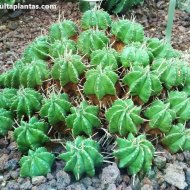Care of the succulent plant Euphorbia meloformis or Melon spurge |
|
The genus Euphorbia, family Euphorbiaceae, includes more than 2,000 species of cactiform plants, shrubs, and herbaceous plants distributed throughout Africa, America, and Madagascar. Some species are: Euphorbia meloformis, Euphorbia viguieri, Euphorbia bubalina, Euphorbia lomelii, Euphorbia enopla, Euphorbia echinus, Euphorbia coerulescens, Euphorbia characias, Euphorbia candelabrum, Euphorbia canariensis, Euphorbia obesa, Euphorbia resinifera, Euphorbia tithymaloides, Euphorbia regis-jubae, Euphorbia royleana, Euphorbia trigona, Euphorbia bivonae, Euphorbia rigida, Euphorbia handiensis, Euphorbia balsamifera. Common name: Melon spurge. This species is native to South Africa. They are slow-growing cactiform succulent dioecious plants that form colonies and reach 20 cm (7.87") in height. The rounded stems have 8-12 ribs with green and purple bands and may or may not have spines on the rib margins. They produce small yellow flowers on long peduncles that are not decorative. Melon spurge is used in rockeries, in cactus and succulent gardens and in pots for patios, terraces and as indoor plants. Euphorbia meloformis prefers full sun but also grows in semi-shade exposure. It does not resist frost well. Melon spurge grows in any soil that is well drained and does not contain much organic matter. Always water moderately, waiting for the substrate to dry completely. Reduce watering in autumn and do not water in winter. Euphorbia meloformis does not need fertilizer or pruning. Melon spurge is a plant resistant to the usual pests and diseases but sensitive to excess moisture. If it's grown indoors it is important that it has good ventilation. Euphorbia meloformis is propagated from seeds sown in spring or summer and by separation of suckers. |
Images of the succulent plant Euphorbia meloformis or Melon spurge |
Find plants
Euphorbia meloformis or Melon spurge | Care and Growing
© 2026 FavThemes

